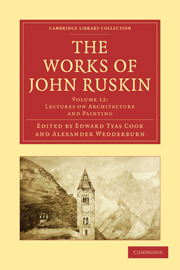Book contents
- Frontmatter
- Contents
- LIST OF ILLUSTRATIONS
- INTRODUCTION TO THIS VOLUME
- PART I “LECTURES ON ARCHITECTURE AND PAINTING” (1854)
- PART II REVIEWS, LETTERS, AND PAMPHLETS ON ART (1844–1854)
- 1 REVIEW OF LORD LINDSAY'S “HISTORY OF CHRISTIAN ART” (1847)
- 2 REVIEW OF EASTLAKE'S “HISTORY OF OIL-PAINTING” (1848):–
- 3 SAMUEL PROUT (1849)
- 4 LETTERS ON THE PRE-RAPHAELITE ARTISTS (1851, 1854)
- 5 PRE-RAPHAELITISM (PAMPHLET, 1851)
- 6 LETTERS ON THE NATIONAL GALLERY (1847, 1852)
- 7 THE OPENING OF THE CRYSTAL PALACE, CONSIDERED IN SOME OF ITS RELATIONS TO THE PROSPECTS OF ART (PAMPHLET, 1854)
- APPENDIX TO PART II
- PART III “NOTES ON THE CONSTRUCTION OF SHEEPFOLDS” (1851)
- APPENDIX TO PART III
- PART IV LETTERS ON POLITICS (1852)
- Plate section
3 - SAMUEL PROUT (1849)
Published online by Cambridge University Press: 05 November 2011
- Frontmatter
- Contents
- LIST OF ILLUSTRATIONS
- INTRODUCTION TO THIS VOLUME
- PART I “LECTURES ON ARCHITECTURE AND PAINTING” (1854)
- PART II REVIEWS, LETTERS, AND PAMPHLETS ON ART (1844–1854)
- 1 REVIEW OF LORD LINDSAY'S “HISTORY OF CHRISTIAN ART” (1847)
- 2 REVIEW OF EASTLAKE'S “HISTORY OF OIL-PAINTING” (1848):–
- 3 SAMUEL PROUT (1849)
- 4 LETTERS ON THE PRE-RAPHAELITE ARTISTS (1851, 1854)
- 5 PRE-RAPHAELITISM (PAMPHLET, 1851)
- 6 LETTERS ON THE NATIONAL GALLERY (1847, 1852)
- 7 THE OPENING OF THE CRYSTAL PALACE, CONSIDERED IN SOME OF ITS RELATIONS TO THE PROSPECTS OF ART (PAMPHLET, 1854)
- APPENDIX TO PART II
- PART III “NOTES ON THE CONSTRUCTION OF SHEEPFOLDS” (1851)
- APPENDIX TO PART III
- PART IV LETTERS ON POLITICS (1852)
- Plate section
Summary
SAMUEL PROUT
1. The first pages in the histories of artists, worthy the name, are generally alike; records of boyish resistance to every scheme, parental or tutorial, at variance with the ruling desire and bent of the opening mind. It is so rare an accident that the love of drawing should be noticed and fostered in the child, that we are hardly entitled to form any conclusions respecting the probable result of an indulgent foresight; it is enough to admire the strength of will which usually accompanies every noble intellectual gift, and to believe that, in early life, direct resistance is better than inefficient guidance. Samuel Prout—with how many rich and picturesque imaginations is the name now associated!—was born at Plymouth, September 17th, 1783, and intended by his father for his own profession; but although the delicate health of the child might have appeared likely to induce a languid acquiescence in his parent's wish, the love of drawing occupied every leisure hour, and at last trespassed upon every other occupation. Reproofs were affectionately repeated, and every effort made to dissuade the boy from what was considered an “idle amusement,” but it was soon discovered that opposition was unavailing, and the attachment too strong to be checked.
- Type
- Chapter
- Information
- The Works of John Ruskin , pp. 303 - 316Publisher: Cambridge University PressPrint publication year: 2010First published in: 1903

